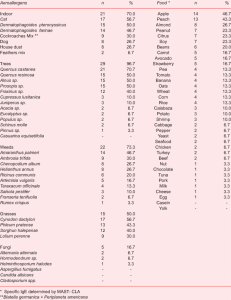Oral Allergy Syndrome (OAS), also known as pollen-food syndrome, is a unique form of food allergy primarily classified under Type I hypersensitivity reactions, which are mediated by Immunoglobulin E (IgE). This condition arises when individuals allergic to pollen consume fresh fruits or vegetables containing allergens similar to those found in the pollen they react to. This results in allergic symptoms in the mouth and throat, and sometimes systemic symptoms, due to an immune response triggered by structural similarities between airborne and food allergens.

Rapid Onset and Symptoms of OAS
OAS typically manifests swiftly, with allergic reactions occurring within 5 to 10 minutes after consuming raw fruits or vegetables, though some individuals may experience symptoms up to an hour later. Predominantly, symptoms are localized to the oropharyngeal area, including itching and swelling of the mouth and throat, sometimes accompanied by tingling or a burning sensation, hoarseness, facial erythema around the mouth, and numbness. These symptoms usually persist for several minutes to a few days. Extramural symptoms are rarer but can include itchy nose and ears, allergic rhinitis, and conjunctivitis. Gastrointestinal reactions such as vomiting and diarrhea, asthma, systemic urticaria, and even life-threatening allergic reactions in approximately 1.7% of OAS sufferers have been observed, underscoring the variability in individual reactions.
The Role of IgE in OAS
The foundation of OAS lies in its IgE-mediated allergic mechanism. When individuals with OAS consume specific raw foods, their immune system mistakenly identifies the food proteins, similar to pollen allergens, as harmful. This misidentification triggers the release of IgE antibodies, which bind to the allergens and activate mast cells and basophils. The activation of these cells leads to the release of histamine and other inflammatory mediators, causing the symptoms associated with OAS. This intricate process highlights the crucial role of IgE in the development and manifestation of OAS symptoms.
Managing and Treating OAS
Prevention and management strategies for OAS largely mirror those applied to other food allergies, emphasizing the avoidance of foods that trigger OAS symptoms as the cornerstone of prevention. Individuals who have experienced severe allergic reactions, such as anaphylactic shock, should rigorously avoid allergenic foods that provoke such reactions. It is also advisable for these individuals to carry emergency medication, including epinephrine auto-injectors, antihistamines, and corticosteroids, to mitigate severe outcomes.
The significance of personalized management cannot be overstated in the context of OAS. Given the individual variability in reactions, a tailored approach is essential. This involves not only identifying and avoiding specific trigger foods but also considering potential treatment options like immunotherapy. Allergen-specific immunotherapy, which gradually exposes the patient to increasing amounts of the allergen, aims to desensitize the immune system to the allergen, potentially reducing or eliminating allergic reactions. However, the effectiveness and applicability of immunotherapy for OAS specifically require careful evaluation by an allergist or immunologist.

Frequency of sensitization to aeroallergens and food in patients with oral allergy syndrome.1
Conclusion
Oral Allergy Syndrome is a complex interaction between environmental and food allergens mediated by IgE antibodies. Its rapid onset, predominance of localized symptoms, and potential for severe reactions highlight the importance of awareness and understanding. Effective management involves avoidance of triggers, emergency preparedness, and consideration of long-term treatment strategies like immunotherapy. As research continues to unravel the mechanisms underlying OAS and other IgE-mediated allergies, it is hoped that more personalized treatment options will emerge for those affected by this challenging condition.
Reference
- Barajas, Martín Bedolla. “Food Allergy Diagnosis and Treatment: 431 Frequency and Characterization of Oral Allergy Syndrome in Mexican Adults with Nasal Pollinosis.” The World Allergy Organization JournalSuppl 2 (2012): S154.

